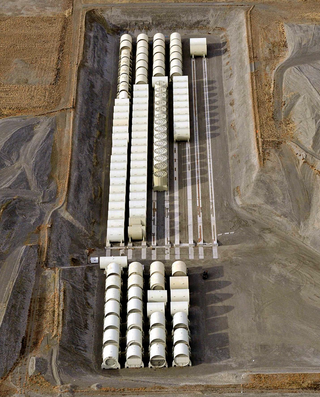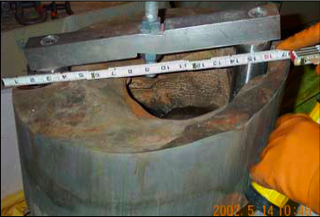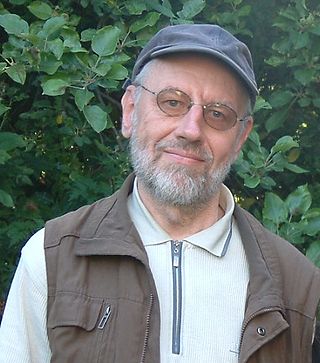Related Research Articles

United States naval reactors are nuclear reactors used by the United States Navy aboard certain ships to generate the steam used to produce power for propulsion, electric power, catapulting airplanes in aircraft carriers, and a few more minor uses. Such naval nuclear reactors have a complete power plant associated with them. All U.S. Navy submarines and supercarriers built since 1975 are nuclear-powered by such reactors. There are no commissioned conventional (non-nuclear) submarines or aircraft carriers left in the U.S. Navy, since the last conventional carrier, USS Kitty Hawk, was decommissioned in May 2009. The U.S. Navy had nine nuclear-powered cruisers with such reactors also, but they have since been decommissioned. Reactors are designed by a variety of contractors, then developed and tested at one of several government owned and prime contractor-operated facilities: Bettis Atomic Power Laboratory in West Mifflin, Pennsylvania and its associated Naval Reactors Facility in Idaho, and Knolls Atomic Power Laboratory in Niskayuna, New York and its associated Kesselring site in West Milton, New York, all under the management of the office of Naval Reactors. Sometimes there were full-scale nuclear-powered prototype plants built at the Naval Reactors Facility, Kesselring, and Windsor to test the nuclear plants, which were operated for years to train nuclear-qualified sailors.

The Three Mile Island accident was a partial meltdown of the Three Mile Island, Unit 2 (TMI-2) reactor on the Susquehanna River in Londonderry Township, Pennsylvania, near the Pennsylvania capital of Harrisburg. It began at 4 a.m. on March 28, 1979. It is the most significant accident in U.S. commercial nuclear power plant history. On the seven-point International Nuclear Event Scale, it is rated Level 5 – Accident with Wider Consequences.

A boiling water reactor (BWR) is a type of light water nuclear reactor used for the generation of electrical power. It is a design different from a Soviet graphite-moderated RBMK. It is the second most common type of electricity-generating nuclear reactor after the pressurized water reactor (PWR), which is also a type of light water nuclear reactor. The main difference between a BWR and PWR is that in a BWR, the reactor core heats water, which turns to steam and then drives a steam turbine. In a PWR, the reactor core heats water, which does not boil. This hot water then exchanges heat with a lower pressure system, which turns water into steam that drives the turbine. The BWR was developed by the Argonne National Laboratory and General Electric (GE) in the mid-1950s. The main present manufacturer is GE Hitachi Nuclear Energy, which specializes in the design and construction of this type of reactor.

The Nuclear Regulatory Commission (NRC) is an independent agency of the United States government tasked with protecting public health and safety related to nuclear energy. Established by the Energy Reorganization Act of 1974, the NRC began operations on January 19, 1975, as one of two successor agencies to the United States Atomic Energy Commission. Its functions include overseeing reactor safety and security, administering reactor licensing and renewal, licensing radioactive materials, radionuclide safety, and managing the storage, security, recycling, and disposal of spent fuel.

A nuclear and radiation accident is defined by the International Atomic Energy Agency (IAEA) as "an event that has led to significant consequences to people, the environment or the facility. Examples include lethal effects to individuals, large radioactivity release to the environment, reactor core melt." The prime example of a "major nuclear accident" is one in which a reactor core is damaged and significant amounts of radioactive isotopes are released, such as in the Chernobyl disaster in 1986 and Fukushima nuclear disaster in 2011.
A nuclear navy, or nuclear-powered navy, refers to the portion of a navy consisting of naval ships powered by nuclear marine propulsion. The concept was revolutionary for naval warfare when first proposed. Prior to nuclear power, submarines were powered by diesel engines and could only submerge through the use of batteries. In order for these submarines to run their diesel engines and charge their batteries they would have to surface or snorkel. The use of nuclear power allowed these submarines to become true submersibles and unlike their conventional counterparts, they became limited only by crew endurance and supplies.

Nuclear power in the United States is provided by 92 commercial reactors with a net capacity of 94.7 gigawatts (GW), with 61 pressurized water reactors and 31 boiling water reactors. In 2019, they produced a total of 809.41 terawatt-hours of electricity, which accounted for 20% of the nation's total electric energy generation. In 2018, nuclear comprised nearly 50 percent of US emission-free energy generation.

Nuclear safety is defined by the International Atomic Energy Agency (IAEA) as "The achievement of proper operating conditions, prevention of accidents or mitigation of accident consequences, resulting in protection of workers, the public and the environment from undue radiation hazards". The IAEA defines nuclear security as "The prevention and detection of and response to, theft, sabotage, unauthorized access, illegal transfer or other malicious acts involving nuclear materials, other radioactive substances or their associated facilities".
Nuclear history of the United States describes the history of nuclear affairs in the United States whether civilian or military.

Nuclear safety in the United States is governed by federal regulations issued by the Nuclear Regulatory Commission (NRC). The NRC regulates all nuclear plants and materials in the United States except for nuclear plants and materials controlled by the U.S. government, as well those powering naval vessels.

The anti-nuclear movement in the United States consists of more than 80 anti-nuclear groups that oppose nuclear power, nuclear weapons, and/or uranium mining. These have included the Abalone Alliance, Clamshell Alliance, Committee for Nuclear Responsibility, Nevada Desert Experience, Nuclear Information and Resource Service, Physicians for Social Responsibility, Plowshares Movement, Women Strike for Peace, Nukewatch, and Women's International League for Peace and Freedom. Some fringe aspects of the anti-nuclear movement have delayed construction or halted commitments to build some new nuclear plants, and have pressured the Nuclear Regulatory Commission to enforce and strengthen the safety regulations for nuclear power plants. Most groups in the movement focus on nuclear weapons.
The GE Three are three nuclear engineers who "blew the whistle" on safety problems at nuclear power plants in the United States in 1976. The three nuclear engineers gained the attention of journalists and the anti-nuclear movement. The GE Three returned to prominence in 2011 during the Fukushima Daiichi nuclear disaster.
George Galatis is a senior nuclear engineer and whistleblower who reported safety problems at the Millstone 1 Nuclear Power Plant, relating to reactor refueling procedures, in 1996. The unsafe procedures meant that spent fuel rod pools at Unit 1 had the potential to boil, possibly releasing radioactive steam throughout the plant. Galatis was the subject of a Time magazine cover story on March 4, 1996. Millstone 1 was permanently closed in July 1998.

Nuclear Power School (NPS) is a technical school operated by the U.S. Navy in Goose Creek, South Carolina as a central part of a program that trains enlisted sailors, officers, KAPL civilians and Bettis civilians for shipboard nuclear power plant operation and maintenance of surface ships and submarines in the U.S. nuclear navy. As of 2020 the United States Navy operates 98 nuclear power plants, including 71 submarines, 11 aircraft carriers, and three Moored Training Ships (MTS) and two land-based training plants. NPS is the centerpiece of the training pipeline for U.S. Navy nuclear operators. It follows initial training at Nuclear Field "A" School or a college degree, and culminates with certification as a nuclear operator at one of the Navy's two Nuclear Power Training Units (NPTU). As of 2020, since training the crew of the first nuclear powered vessel in 1952, the Program has trained and qualified over 142,000 nuclear propulsion plant operators. Since 1955, when Nautilus first got underway on nuclear power, Navy nuclear powered vessels have safely steamed over 166 million miles.

Joseph Mallam Hendrie is a former chairman of the U.S. Nuclear Regulatory Commission (NRC). On August 9, 1977 he was named to a four-year term on the Commission and designated as its chairman by President Jimmy Carter. From 1975 to 1977, Hendrie had served as chairman of the Department of Applied Science at Brookhaven National Laboratory.

The United States Government Accountability Office reported more than 150 incidents from 2001 to 2006 of nuclear plants not performing within acceptable safety guidelines. According to a 2010 survey of energy accidents, there have been at least 56 accidents at nuclear reactors in the United States. The most serious of these was the Three Mile Island accident in 1979. Davis-Besse Nuclear Power Plant has been the source of two of the top five most dangerous nuclear incidents in the United States since 1979. Relatively few accidents have involved fatalities.
Arnold "Arnie" Gundersen is a former nuclear industry executive, and engineer with more than 44 years of nuclear industry experience who became a whistleblower in 1990. Gundersen has written dozens of expert reports for nongovernment organizations and the state of Vermont. Gunderson was a licensed reactor operator from 1971-1972 on Rensselaer Polytechnic Institute's zero-power open-pool university research reactor at the Reactor Critical Facility in Schenectady, New York, where he was a nuclear engineering graduate student.

Rainer Moormann is a German chemist and nuclear whistleblower. He grew up in Osnabrück. After finishing highschool he studied physical chemistry in Braunschweig and received a doctor's degree with Raman spectroscopic and theoretical investigations on hydrogen bonds in liquids.
David A. Lochbaum was the Director of the Nuclear Safety Project for the Union of Concerned Scientists (UCS). A nuclear engineer by training, he worked in nuclear power plants for nearly two decades. Lochbaum has written numerous articles and reports on various aspects of nuclear safety and published two books.
This is a history of nuclear power.
References
- 1 2 Saxon, Wolfgang (July 31, 1999). "G. C. Minor, 62, an Engineer Who Criticized Nuclear Power". The New York Times .
- 1 2 "The San Jose Three". Time . February 16, 1976.
- ↑ "The Struggle over Nuclear Power". Time. March 8, 1976. Archived from the original on August 14, 2013.
[[Category:1999 deaths]
